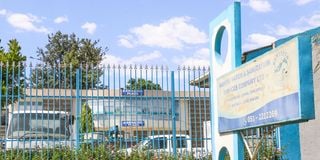Explainer: Why your water bill in Nakuru just went up and who's to blame

A section of Nakuru Water and Sanitation Services Company (NAWASSCO) offices. The utility just announced an upward tariff adjustment for Nakuru residents effective July 1,2025.
You must have received a message notification or notice on an upward water tariffs from the Nakuru Water and Sanitation Services Company (NAWASSCO), effective July 1, 2025.
The question residents are now asking is: why now and why these rates?
Mtaa Wangu spoke to the Water Services Regulatory Board (WASREB), the body tasked with regulating the water sector to ensure the provision of efficient, affordable, and sustainable water and sanitation services.
Here is why you will need to pay more for your water.
In an interview with WASREB CEO, Richard Cheruiyot, he notes that the tariff changes were approved after considering NAWASSCO’s application for adjustment of tariffs for the period 2024/2025 to 2029/2030.
He notes that for the period 2024/2025 to 2029/2030, the cost of water has increased by 61 percent, up from Sh 59 on the lifeline block tariff (1-6 meters cubic) to Sh95.
He, however, notes that before a new tariff is adjusted, WASREB makes several considerations, among them, if the utility conducted a public engagement with stakeholders and reviewing whether the utility met its targets from the previous tariff among other requirements.
In the case of NAWASSCO, WASREB Tariff Manager, Robert Mutai says the company recorded some improvements under the previous tariffs therefore qualifying for approval of new tariffs.
He says that in the period between 2018–2022, the company improved its water and sewer coverage and service delivery to residents.
“Nawassco improved its water coverage by one percent, increasing it from 95 percent to 96 percent. In this period, the utility expanded water coverage in areas of Koinange, Mwaraki East, South and Central zones, Keratina, Free Area, Railway Line, and Oginga Odinga,” he explains.
Additionally, he notes the utility also recorded an improvement in sewerage coverage by one percent, up from 32 to 33 percent, while maintaining water quality at an impressive 100 percent.
Other than that, he also commended the 22-hour water access that Nawassco recorded during this period.
He, however, noted that the utility is expected to reduce its non-revenue water (water produced but lost through leaking pipes, faulty meter readings) to meet the national standard of 25 percent, down from the current 26 percent.
Speaking on future expectations for Nawassco, Mutai notes that for the period between 2025 to 2030, they are expected to improve water and sewerage coverage to 100 percent and 42 percent respectively, and also increase water access to 24 hours.
Additionally, he notes that new areas targeted for increased water coverage under the new tariff include Umoja which should be covered between (2025/2026), followed by Kiamunyeki (2026/2027), Maili Sita (2027/2028), Mzee Wanyama (2028/2029), and finally Ng’ambo in 2029/2030.
Mutai concludes by noting that Nawassco has ranked highly in performance evaluation determined by a utility’s performance across Key Performance Indicators (KPIs). In 2024 they ranked first with a score of 166 out of 200 points.

